




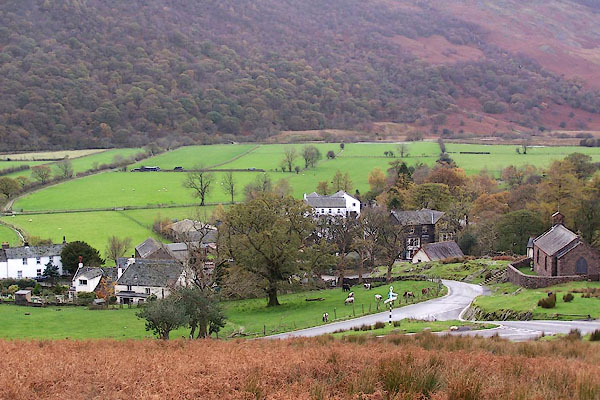
BJZ31.jpg (taken 7.11.2005)
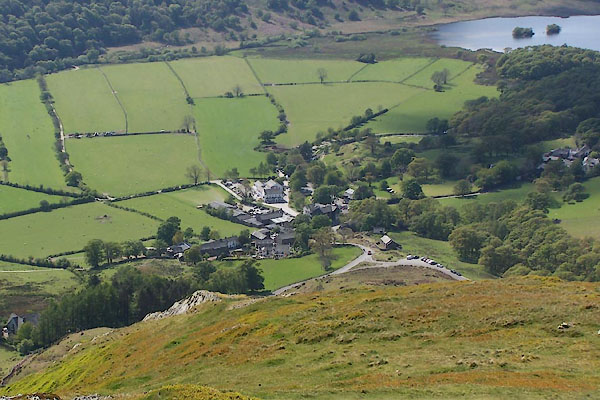
BUM99.jpg (taken 3.5.2011)
placename:- Buttermire Chapelry
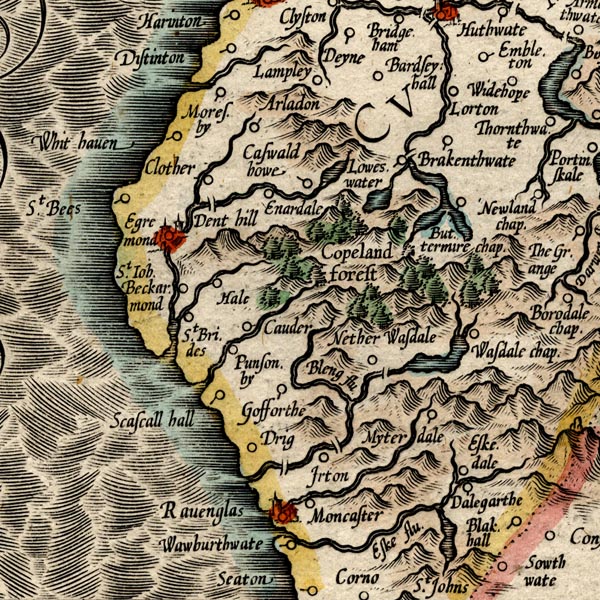
MER8CumE.jpg
"Buttermire chap."
circle
item:- JandMN : 169
Image © see bottom of page
placename:- Buttermire

D4NY11NE.jpg
"Buttermire"
blocks, and usually a church, labelled in upright lowercase; a village and locality
item:- Carlisle Library : Map 2
Image © Carlisle Library
 goto source
goto sourcePage 135:- "..."
"... Some traces of industry obtruding"
 goto source
goto sourcePage 136:- "themselves at the foot of the glen, disturb the solemn solitude with which the eye and mind have been entertained, and point out your return to society; for now you approach the village of Buttermere, which is situated between the lakes and consists of sixteen houses. The chapel here is very small, the stipend not large, for though twice augmented with the queen's bounty, it exceeds not twenty pounds per annum. This is one of the cures Mr. Pennant mentions; but the perquisites of the clog-shoes, harden-sark, whittle-gate, and goose-gate, have no better support than in some ancient, and probably idle tale."
"The life of the inhabitants is purely pastoral. A few hands are employed in the slate quarries; the women spin woollen yarn, and drink tea. ..."
placename:- Buttermere
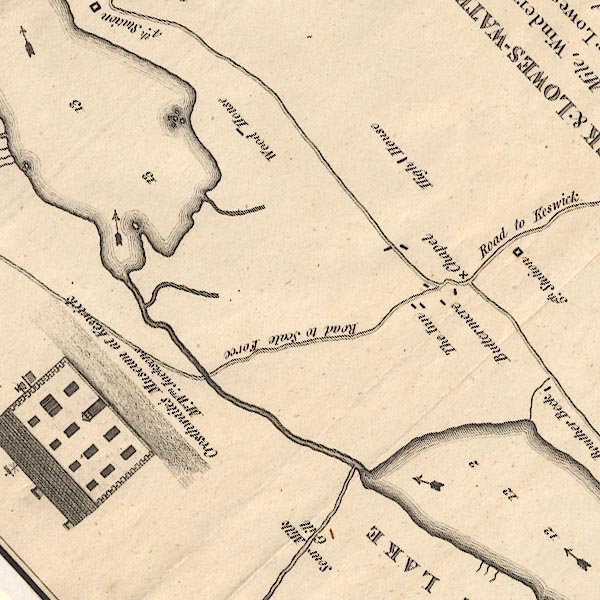
CT8NY11T.jpg
"Buttermere"
item:- Armitt Library : 1959.191.2
Image © see bottom of page
placename:- Buttermere
 goto source
goto sourcePage 85:- "..."
"Buttermere is a small chapelry, consisting of about sixteen or eighteen families, who each of them keep a few sheep as in Borrowdale, and all the mountainous parts; the men mostly work at the blue-slate quarries, which here are carried on to a great extent. ..."
"Buttermere is a chapel of ease under Lorton, though Lorton is but a chapel of ease under Brigham. ..."
"..."
 goto source
goto sourcePage 86:- "..."
"The rocks and mountains about Buttermere are truly awful and romantic; but, as I said before, the same kind of views may be seen where the roads are better, and the valleys more inhabited. The landscape-painter will find variety of excellent stations here, as in many other places with stupendous amphitheatres of broken-toped mountains, whose bases are scattered with woods; and as every station adds a fresh view, the greatest connoisseur can hardly distinguish the best. ..."
 goto source
goto sourceGentleman's Magazine 1792 p.1115 "[Buttermere] ... They said, with concern, until a fortnight ago they had no regular schoolmaster these two years; in short, since the period of chusing their clergyman was taken from them. The chapel and the school serves for both purposes, and I could almost reach the roof with my head. The inhabitants, time out of mind, used to appoint their own clergyman, and he was generally chosen with full consent. Perhaps it was the very poorest livelihood in the kingdom, even with the addition of Queen Anne's bounty; but it was a vehicle for a minor priest to get superior orders; and there never was a want of candidates. They now say they have lost their right; at any rate, they are afraid to claim it, as they are more in dread of the Great Eagle of the North than the eagles which build in their mountains; they think it a judgment upon them for unanimously voting au contraire at a contested election. But, whatever may be the reason, they are left to go to heaven as quietly as they can. The Schoolmaster, without being a Parson, officiates as such; and a clergyman from Lorton, the parish-church, comes over about once in six weeks to administer the Sacrament, which may be the means of preserving the bounty. In this forlorn manner is the service*performed in the village of Buttermere. Luckily, it could not have happened in a village where it appears less wanted; but as good, harmless people always regret the loss of a good custom, they regret it."
""The village consists of fourteen families, and some of them are rich people; that is, they may have fifty pounds a-year landed property, and healthful flocks of sheep. We had salt provisions and vegetables for dinner; and I do not think there was a fresh joint in the valley. The ale was home-brewed, and good, but rather too strong for our taste. If you are fond of strong ale, Buttermere is famous for it. Wine and spirits are not sold here; and they are so far from the excise, they pay their duty by compromise, ten pence halfpenny a-week. The landlady says they do not sometimes sell six pennyworths a-week .... On our return, we met a woman with a loaded horse. She had been to Keswick market, laying-in meat and other necessaries for herself and neighbours. This amicable custom is equaled by the following: when a person is sick, or a woman about to lie-in, a horseman is sent express to Keswick or Cockermouth for a surgeon, and the neighbours send a relay of horses to expedite him. ..."
""SALLY OF BUTTERMERE."
""Her mother and she were spinning woollen yarn in the back kitchen. On our going into it, the girl flew away as swift as a mountain-sheep, and it was until our return from Scale-Force that we could say we first saw her. She brought-in part of our dinner, and seemed to be about fifteen. Her hair was thick and long, of a dark brown, and, though unadorned with ringlets, did not seem to want them. Her face was a fine contour, with full eyes, and lips as red as vermillion. Her cheeks had more of the lily than the rose; and although she had never been out of the village (and, I hope, will have no ambition to wish it), she had a manner about her which seemed better calculated to set off dress than dress her. She was a very Lavinia, 'Seeming, when unadorn'd, adorn'd the most,' When we first saw her at her distaff, after she got the better of her first fears, she looked an angel; and I doubt not but she is the reigning lily of the valley. Ye travellers of the Lakes, if you visit this obscure place, such will find the fair Sally of Buttermere!""
""The inhabitants in general about these mountainous countries are not so tall or lusty as in many others; perhaps, as it requires great industry to get a livelihood, the growth of their children is checked by early labour. They live to a very advanced age; and the faces of the very old are strong and healthfully marked with deep short wrinkles. The middle-aged are commonnly handsome; their youth are ruddy and sun-burnt; their children have the faces of Cherubim, and seem to have "the milk of Dorothy" flowing purely in their veins. They are not only affectionate to their parents, but friendly amongst each other; and a man would run risk of his life in deep snow, in venturing over the steepest mountains to attend the funeral of a friend. They have the highest respect for the dead; perhaps to a degree bordering upon superstition; and they rather rob the living by the expence they put themselves to at a funeral. But as a livelihood, not a love of gain, is their grand consideration, they are too friendly and industrious to want; and I did not see (except some little vagrants at Keswick) one person that asked our charity. Their food is homely: they prefer thin oat-cake to wheat-bread; and they are fond of the natural products of the earth, which may be the reason of seeing large families in every house, for we did not call at a cottage that had less than three children. Their drink consists of butter-milk and whey, and, occasionally, a draught of"
"*"As the chapel enjoys Queen Anne's bounty, should not the diocesan take care they have a proper pastor? But I cannot suppose he is informed of it.""
 goto source
goto sourceGentleman's Magazine 1792 p.1116 "stout ale. Spirits are seldom used to excess; their baneful influence is almost unknown; they are taken as cordials, and I hope they will never make further encroachment." ..."
""The high roads are generally excellent, and the commons are well supplied with finger-posts. A road once made up will last a long while; the first expence is heavy, but they are not much burthened by after-repairs, or the traveller by turnpikes. .... I do not think his Majesty has more loyal subjects in his dominions; and if Mr. Pitt should cast a look upon this humble production, I have the satisfaction of telling him, the Proclamation was upon all the church-doors, and they loooked as clean as the day they were put up, except that we could sometimes trace the mark of a finger that had conned it over.""
placename:- Buttermere
 goto source
goto sourcepage 67:- "..."
"The horse-road to Buttermere is through the vale of Newlands, but the carriage-road is part of the way on the Cockermouth road over Whinlatter, and through a part of the vale of Lorton, by Crummock Water to the inn at Buttermere. - The inn at Scale Hill, (which is about half a mile from the outlet of Crummock Water) and the inn at Buttermere, are both of them excellent stationary places; from which, to see Buttermere, Crummock Water, Lows Water,and Ennerdale Water. The inn at Buttermere lies at about an"
 goto source
goto sourcepage 68:- "equal distance from the two lakes of Buttermere and Crummock; and the mountains round the valley rise in precipitous grandeur, to a great height. Honister Crag, at the Borrowdale end of the valley, is a steep high rock, from the side of which is got an abundance of slate. - The four conical topped mountains, High Pike, High Steel, High Crag, and Red Pike, are on the western side of the lake of Buttermere, and Robinson on the eastern - the river connecting Buttermere and Crummock Waters, runs at the feet of the western mountains, and is about half a mile long - the inn is at the bottom of the Keswick road, on the east side of the vale, and the immediate grounds are of sweet pasturage, with woods elegantly sprinkled over it - Melbreak skirts the eastern, and Rannerdale Knott, Grasmire and Whiteside, the western side of Crummock Water."
placename:- Buttermere
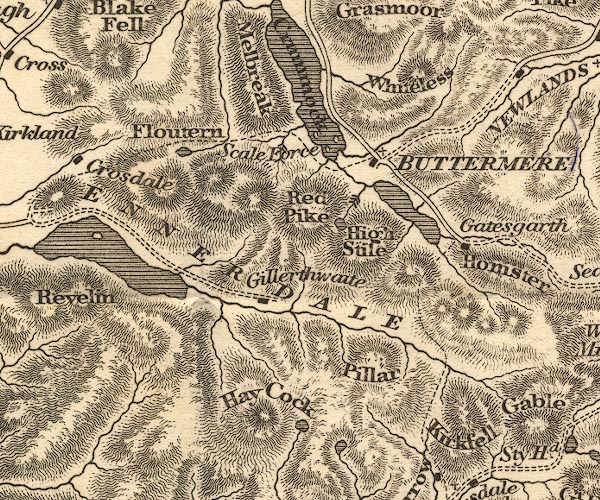
OT02NY11.jpg
"BUTTERMERE"
item:- JandMN : 48.1
Image © see bottom of page
item:- geology
 goto source
goto sourcePage 154:- "... Veins of lead ore occur in several places; and have been worked between Skiddaw and Saddleback, in Thornthwaite, Newlands, and Buttermere; but one in the parish of Loweswater, and one below the level of Derwent Lake, are the most productive at present in this district."
"..."
 goto source
goto sourcePage 164:- "neighbourhood of the lakes. Bowlders from the sienite of Buttermere and Ennerdale are found on the west coast of Cumberland; but not in the vales of Keswick or Windermere. ..."
placename:- Buttermere
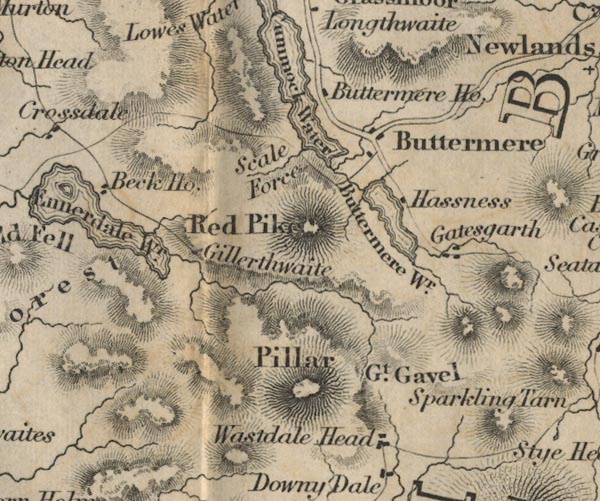
FD02NY11.jpg
"Buttermere"
item:- JandMN : 100.1
Image © see bottom of page
placename:- Buttermere
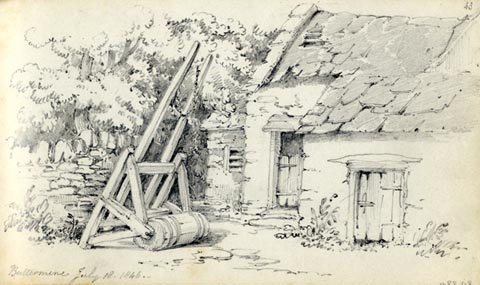 click to enlarge
click to enlargeAS0248.jpg
"Buttermere. July 18. 1846."
page number "43"
item:- Armitt Library : 1958.488.48
Image © see bottom of page
placename:- Buttermere
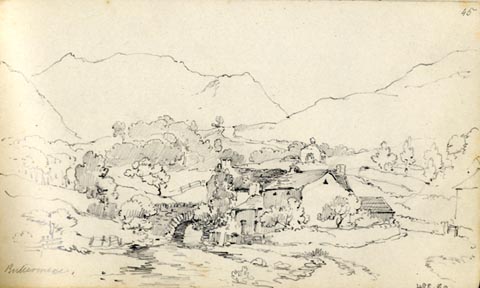 click to enlarge
click to enlargeAS0250.jpg
"Buttermere."
page number "45"
item:- Armitt Library : 1958.488.50
Image © see bottom of page
placename:- Buttermere
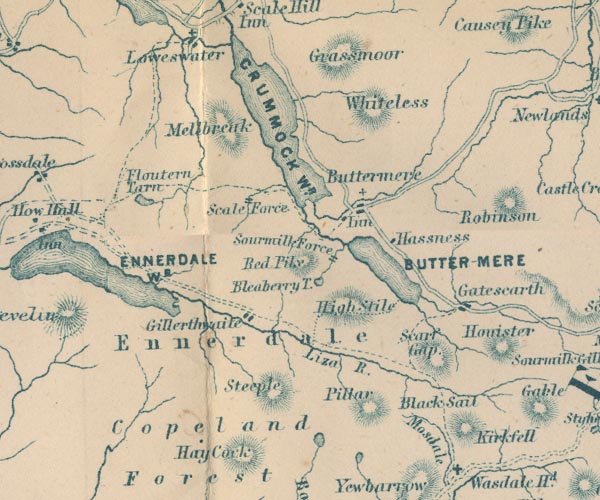
GAR2NY11.jpg
"Buttermere"
blocks, settlement, and cross, a church
item:- JandMN : 82.1
Image © see bottom of page
placename:- Buttermere
 click to enlarge
click to enlargePYN212.jpg
"PAINTED BY J. B. PYNE. / W. GAUCI LITH. / MANCHESTER, PUBLISHED BY THOMAS AGNEW & SONS, 1853. / Buttermere / M & N HANHART IMPT."
From the descriptive text:- "The geology of this district is very interesting. Red Pike is a huge syenitic mass, and the greater porrtion of the chain of rugged hills between Buttermere, Crummock Water, Lowes Water, and Ennerdale, are irruptive igneous masses, which have been forced through the middle slates in a molten state, as in some parts they have overspread them. These irruptive rocks are composed mostly of red felspar, with quartz interspersed. Syenite is a compaound granular rock, composed of quartz, hornblend, and felspar. It differs from granite only in containing hornblend instead of mica. The name is from Syene, in Upper Egypt. many of the monuments and statues of that wonderful country are cut in syenite. Felspar is composed of silex, alumine, lime, and potash. There are many beautiful varieties of felspar in this neighbourhood."
item:- Armitt Library : A6678.13
Image © see bottom of page
placename:- Buttermere
 click to enlarge
click to enlargePYN221.jpg
"PAINTED BY J. B. PYNE. / W. GAUCI LITH. / MANCHESTER, PUBLISHED BY THOMAS AGNEW & SONS, 1853. / The Vales of Ennerdale and Buttermere / M & N HANHART IMPT."
item:- Armitt Library : A6678.22
Image © see bottom of page
placename:- Buttermere
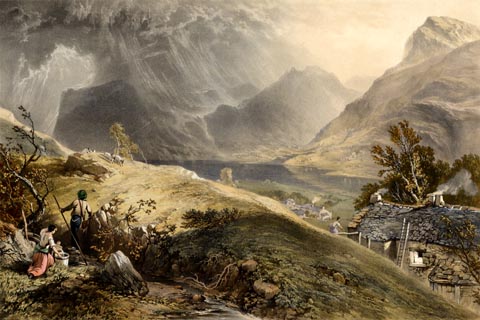 click to enlarge
click to enlargePYN412.jpg
item:- Armitt Library : A6677.13
Image © see bottom of page
placename:- Buttermere
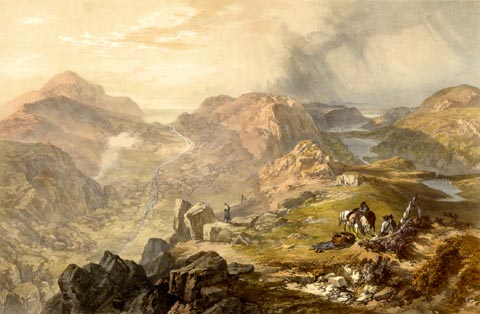 click to enlarge
click to enlargePYN421.jpg
item:- Armitt Library : A6677.22
Image © see bottom of page
 Martineau Directory 1855
Martineau Directory 1855item:- erosion
 goto source
goto sourcePage 131:- "... Buttermere ... the attention of the traveller has hardly been sufficiently called to the stormy character of this central district, as shown by the aspect of the mountains. No where else are they so scarred with weather marks, or so diversified in colouring from new rents in the soil. Long sweeps of orange and grey stones descend to Crummock Water; and above, there are large hollows, like craters, filled now with deep blue shadows, and now with tumbling white mists, above which yellow or purple peaks change their hue with every hour of the day, or variation of the sky. The bare, hot-looking débris on the Melbreak side, the chasms in the rocks, and the sudden swellings of the waters, tell of turbulence in all seasons. ..."
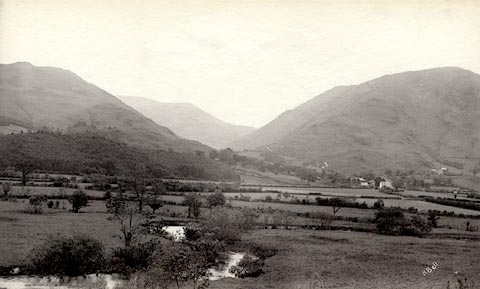 click to enlarge
click to enlargeHB0426.jpg
internegative at lower right:- "H. Bell"
item:- Armitt Library : ALPS80
Image © see bottom of page
placename:- Buttermere
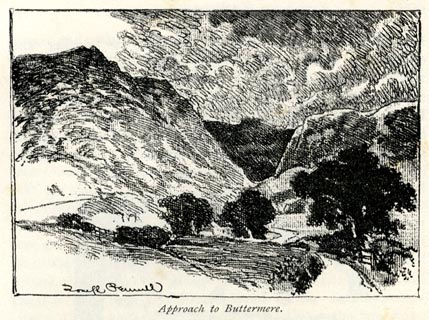 click to enlarge
click to enlargeBRL132.jpg
On page 150 of Highways and Byways in the Lake District, by A G Bradley.
printed at bottom:- "Approach to Buttermere."
item:- JandMN : 464.32
Image © see bottom of page
placename:- Buttermere
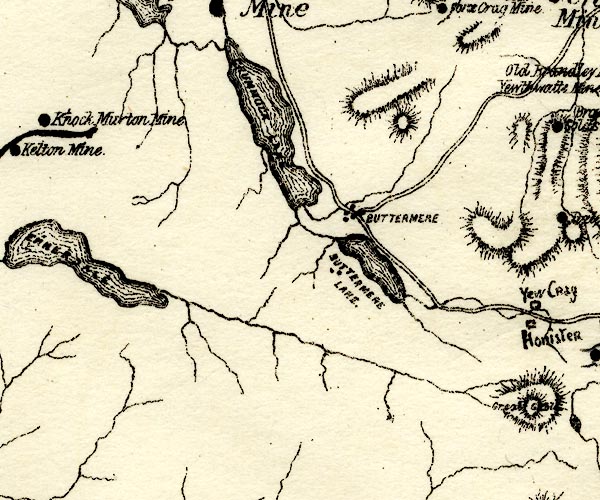
PST2NY11.jpg
"BUTTERMERE"
dots, roads
item:- JandMN : 162.2
Image © see bottom of page
placename:- Buttermere
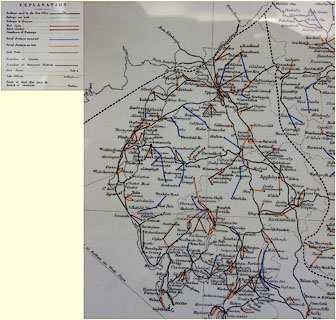 click to enlarge
click to enlargePOF7Cm.jpg
"Buttermere"
map date 1909
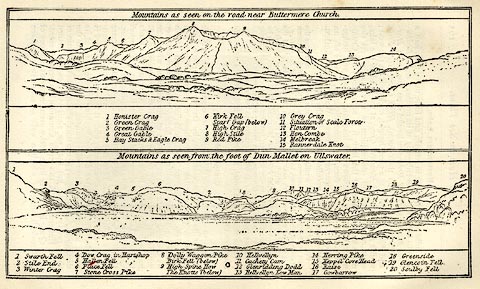 click to enlarge
click to enlargeRG0105.jpg
"1 Honister Crag 2 Green Crag 3 Green Gable 4 Great Gable 5 Hay Stacks &Eagle Crag 6 Kirk Fell / Scarf Gap (below) 7 High Crag 8 High Stile 9 Red Pike 10 Grey Crag 11 Situation of Scale Force 12 Floutern 13 Hen Combe 14 Melbreak 15 Rannerdale Knot"
On p.162 in the Red Guide guide book, Guide to the English Lakes.
item:- JandMN : 102.6
Image © see bottom of page
placename:- Vale of Buttermere
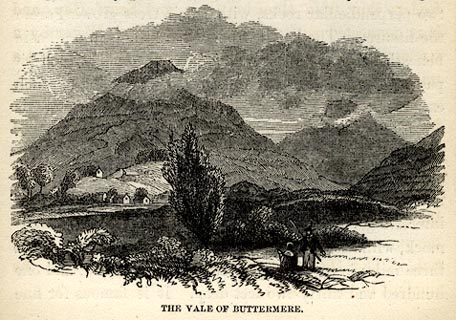 click to enlarge
click to enlargeSYL152.jpg
On p.205 of Sylvan's Pictorial Guide to the English Lakes.
printed at bottom:- "THE VALE OF BUTTERMERE."
item:- Armitt Library : A1201.52
Image © see bottom of page
placename:- Buttermere
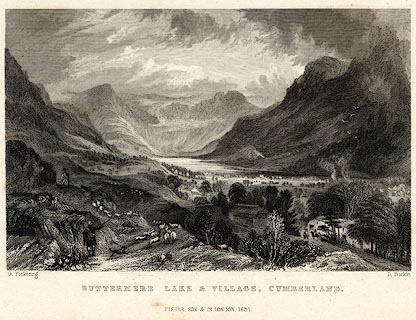 click to enlarge
click to enlargePR0056.jpg
vol.3 pl.67 in the set of prints, Westmorland, Cumberland, Durham and Northumberland Illustrated. The shepherd gathering his sheep is in a kilt.
printed at bottom left, right, centre:- "G. Pickering. / D. Buckle. / BUTTERMERE LAKE & VILLAGE, CUMBERLAND. / FISHER, SON &CO. LONDON, 1835."
item:- Dove Cottage : 2008.107.56
Image © see bottom of page

Click to enlarge
BVH17.jpg (taken 17.8.2011)
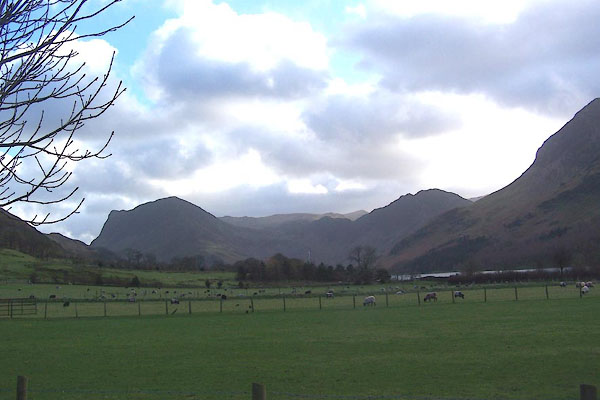
BNC01.jpg View of Fleetwith and Haystacks etc, from Buttermere.
(taken 11.12.2006)

BPA47.jpg Honister in the background.
(taken 16.4.2008)

Click to enlarge
BVP88.jpg Backdrop to Buttermere from SW side; High Snockrigg toGatesgarth.
(taken 1.11.2011)

Click to enlarge
BVP89.jpg Backdrop to Buttermere from SW side; Grasmoor to Gatesgarth.
(taken 1.11.2011)
